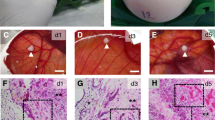Abstract
Porcine luteal cells were collected from corpora lutea in four different stages of the luteal phase and cultured as monolayers. Progesterone (P4) secretion was assayed using radioimmunoassays (Gregoraszczuk, 1991). Luteal cells cultured from porcine corpora lutea collected in the early luteal phase maintained steroidogenic capacity for 6 days in culture until the time comparable with midluteal corpora lutea. Luteal cells collected from mature and regressing corpora lutea did not dedifferentiate during 2 days of culture. After this time secretion of progesterone decreased to undetectable amounts characteristic of old corpora lutea. The regression in the culture progressed. The results demonstrate that the degree of the decline of progesterone depends on the type of corpus luteum, which is connected to particular time intervals of the luteal phase. Before starting experiments it is necessary to take into consideration the stage of the luteal phase from which the material is collected for culture. This study provides evidence that long term culture is useful for investigating a variety of aspects of luteal function only if cells are collected in the early luteal phase. Short term culture is suitable for investigation of cells collected from mid and late luteal phase. Regulation of luteal function is dependent on stage of the luteal phase.
Similar content being viewed by others
References
Gregoraszczuk E and Stoklosowa S (1978) Growth pattern of the cultured porcine corpus luteum cells. Bulletin de L’academie Polonaise des Sciences XXVI, 8: 567–569.
Gregoraszczuk E (1983) Steroid hormone release in cultures of pig corpus luteum and granulosa cells: Effect of LH, hCG, PRL and estradiol. Endocr. Exp. 17: 59–68.
Gregoraszczuk E (1991) The interaction of testosterone and gonadotropins in stimulating estradiol and progesterone secretion by cultures of corpus luteum cells isolated in early and midluteal phase. Endocrinol. Japonica 38: 229–237.
Hoyer PB, Kong W, Crichton EG, Bevan L and Krutzsch PM (1988) Steroidogenic capacity and ultrastructural morphology of cultured ovine luteal cells. Biol. Reprod. 38: 909–920.
Kong W, Marion SL and Hoyer PB (1989) Luteotropic and luteolytic responsiveness of ovine luteal cells in long-term culture. Biol. Reprod. 41: 707–714.
Author information
Authors and Affiliations
Rights and permissions
About this article
Cite this article
Gregoraszczuk, E.L., Wojtusiak, A. Evaluation of the physiological value of porcine luteal cells isolated in various stages of the luteal phase: Tissue culture approach. Cytotechnology 8, 215–217 (1992). https://doi.org/10.1007/BF02522038
Received:
Revised:
Issue Date:
DOI: https://doi.org/10.1007/BF02522038




